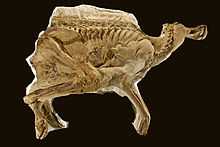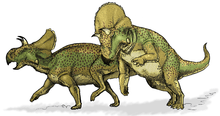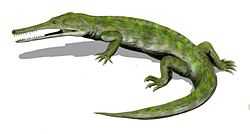Judith River Formation
| Judith River Formation Stratigraphic range: Campanian, 80–75Ma | |
|---|---|
 "Leonardo," a rare intact mummified Brachylophosaurus canadensis uncovered in the Judith River Formation. | |
| Type | Geological formation |
| Unit of | Judith River Group |
| Sub-units | Birch Lake Member, Ribstone Creek Member, Brosseau Member, Victoria Member |
| Underlies | Bearpaw Formation |
| Overlies | Claggett Formation, Pakowki Formation |
| Thickness | max 360 meters (1,180 ft)[2] |
| Lithology | |
| Primary | Siltstone and sandstone |
| Other | Coal, coquinas |
| Location | |
| Coordinates | 47°40′N 109°39′W / 47.667°N 109.650°WCoordinates: 47°40′N 109°39′W / 47.667°N 109.650°W |
| Region | Montana |
| Country |
|
| Type section | |
| Named for | Confluence of Judith River and Missouri River |
| Named by | F.V. Hayden, 1871;[3] F.B. Meek, 1876.[4] |
The Judith River Formation is a fossil-bearing geologic formation in Montana, and is part of the Judith River Group. It dates to the upper Cretaceous, between 80 and 75 million years ago, corresponding to the "Judithian" land vertebrate age. It was laid down during the same time period as portions of the Two Medicine Formation of Montana[1] and the Oldman Formation of Alberta.[5] It is an historically important formation, explored by early American paleontologists such as Edward Drinker Cope, who named several dinosaurs from scrappy remains found here on his 1876 expedition (such as Monoclonius). Modern work has found nearly complete skeletons of the hadrosaurid Brachylophosaurus.
Lithology
The Judith River Formation is composed of mudstone, siltstone and sandstone.[2] Coal beds, bentonite and coquinas are also observed.
Relationship with other units
The Judith River Formation conformably overlies the Claggett Formation and Pakowki Formation. It is overlain by the Bearpaw Formation.[2] It is equivalent to the Belly River Formation in the southern Canadian Rockies foothills, the Lea Park Formation in central Alberta and the Wapiti Formation in the northwestern plains. To the east, it correlates with the sum of Oldman Formation and Foremost Formation.
Sub-divisions
The Birch Lake Member and Ribstone Creek Member are sandstone units recognized inside the Judith River Formation. Other informal subdivisions include the Brosseau Member and Victoria Member, which are considered obsolete due to their inconsistent lateral distribution.
Fauna
Faunal list follows a review published by Ashok Sahni in 1972 unless otherwise noted.[6]
Color key
|
Notes Uncertain or tentative taxa are in small text; |
Amphibians
There are three potential species of discoglossid frogs. Hip bones, possibly representing a North American member of the European spadefoot toad family are also known from the formation.
| Amphibians of the Judith River Formation | |||||||
|---|---|---|---|---|---|---|---|
| Genus | Species | Location | Stratigraphic position | Abundance | Notes | Images | |
|
H. dilatus |
A siren. | ||||||
|
L. bairdi |
A scapherpetonid salamander. | ||||||
|
O. kayi |
A possible lungless salamander. | ||||||
|
P. copei |
|||||||
|
S. tectum |
A scapherpetonid salamander. | ||||||
Bony fish
| Bony fishes of the Judith River Formation | |||||||
|---|---|---|---|---|---|---|---|
| Genus | Species | Location | Stratigraphic position | Abundance | Notes | Images | |
|
Belonostomus longirostris |
An aspidorhynchiform. | ||||||
|
Kindleia |
K. fragosa |
A bowfin. | |||||
|
L. occidentalis |
A gar. | ||||||
|
?P. sp. |
A bonefish. | ||||||
Cartilaginous fish
| Cartilaginous fishes of the Judith River Formation | |||||||
|---|---|---|---|---|---|---|---|
| Genus | Species | Location | Stratigraphic position | Abundance | Notes | Images | |
|
M. bipartitus |
A stingray. |
||||||
Ornithischian dinosaurs
| Ornithischians reported from the Judith River Formation | |||||||
|---|---|---|---|---|---|---|---|
| Genus | Species | Location | Stratigraphic position | Material | Notes | Images | |
|
A. nesmoi[7] |
A ceratopsid |
| |||||
|
A. lammersi[7] |
"[Two] partial skulls, skeleton, juvenile,"[8] type specimen |
A ceratopsid | |||||
|
B. canadensis |
A hadrosaurid | ||||||
|
C. montanus |
"occipital condyle, paired horn cores,"[9] type specimen |
A dubious ceratopsid | |||||
|
D. calamarius |
"Teeth."[10] |
Nomen dubium | |||||
|
D. pentagonius |
"Fragmentary dentary with teeth,"[10] type specimen |
A dubious hadrosaurid | |||||
|
D. perengulatus |
"Teeth."[10] |
Nomen dubium | |||||
|
D. bicarinatus |
"Isolated teeth."[9] |
Nomen dubium | |||||
|
D. encaustus |
"Single tooth and [five] tooth fragments."[10] "Isolated teeth."[9] |
Nomen dubium | |||||
|
D. haydenianus |
"Isolated teeth."[9] |
Nomen dubium | |||||
|
D. peiganus |
"Tooth."[9] |
Nomen dubium | |||||
|
H. paucidens |
Reclassified as Lambeosaurus? paucidens | ||||||
|
J. tigris[11] |
A ceratopsid | ||||||
|
?"Kritosaurus" |
?"K." breviceps |
A hadrosaurid | |||||
|
?L. paucidens |
"Squamosal, maxilla."[10] |
A hadrosaurid | |||||
|
M. lokii[12] |
Bonebed[12] |
A ceratopsid | |||||
|
M. gemini[13] |
"one apomorphic squamosal"[13] |
A ceratopsid | |||||
|
M. crassus[7] |
"[Five] skulls, [one] complete."[8] Type specimen |
A dubious ceratopsid | |||||
|
Paleoscincus |
P. costatus |
"Tooth,"[14] type specimen |
A dubious ankylosaur | ||||
|
P. grallipes |
"Skeleton lacking skull."[15] |
A dubious hadrosaurid | |||||
|
T. mirabilis |
Isolated teeth, type specimen |
A dubious hadrosaurid | |||||
Choristoderes
| Choristoderes of the Judith River Formation | |||||||
|---|---|---|---|---|---|---|---|
| Genus | Species | Location | Stratigraphic position | Abundance | Notes | Images | |
|
C. sp. |
| ||||||
Crocodilians
| Crocodillians of the Judith River Formation | |||||||
|---|---|---|---|---|---|---|---|
| Genus | Species | Location | Stratigraphic position | Abundance | Notes | Images | |
|
B. montana |
An alligatorid. | ||||||
|
L. canadensis |
An alligatorid. | ||||||
Lizards
| Lizards of the Judith River Formation | |||||||
|---|---|---|---|---|---|---|---|
| Genus | Species | Location | Stratigraphic position | Abundance | Notes | Images | |
|
Chamops |
C. segnis |
A whiptail. | |||||
|
Exostinus |
E. lancensis |
||||||
|
Leptochamops |
L. denticulatus |
A whiptail. | |||||
|
Paraderma |
P. bogerti |
A parasaniwid. | |||||
|
Parasaniwa |
P. wyomingensis |
A parasaniwid. | |||||
Theropod dinosaurs
An unnamed tyrannosaurine is known from the formation.[16]
| Theropods reported from the Judith River Formation | |||||||
|---|---|---|---|---|---|---|---|
| Genus | Species | Location | Stratigraphic position | Material | Notes | Images | |
|
A. lateralis |
Junior synonym of Deinodon horridus[6] |
||||||
|
A. mirandus |
Teeth, type specimen |
Possible junior synonym of Deinodon horridus[6] | |||||
|
Coniornis |
C. altus |
Partial tibiotarsus |
One of the only known freshwater occurrences of a hesperornithid.[19] | ||||
|
D. falculus |
Teeth |
Isolated tyrannosaur teeth classified in the dubious genus Deinodon | |||||
|
D. hazenianus |
Teeth |
Junior synonym of Deinodon horridus[6] | |||||
|
D. horridus |
"Teeth,"[18] type specimen |
Isolated tyrannosaur teeth that formed the basis of the dubious genus Deinodon | |||||
|
D. incrassatus |
Teeth |
Junior synonym of Deinodon horridus[6] | |||||
|
D. lateralis |
Junior synonym of Deinodon horridus[6] | ||||||
|
D. albertensis |
Teeth |
A dromaeosaurid, also found in the Dinosaur Park | |||||
|
D. explanatus |
"Tooth."[20] |
Possible relative of Saurornitholestes | |||||
|
D. laevifrons |
"Tooth."[20] |
Possible relative of Saurornitholestes | |||||
|
O. tenuis |
"Fragmentary metatarsal."[21] |
A possible troodontid or juvenile tyrannosaurid | |||||
|
P. lacustris |
Teeth, type specimen |
An indeterminate maniraptoran, also found in the Dinosaur Park, Milk River, and Kirtland Formations | |||||
|
T. formosus |
Teeth (type specimen), vertebra, egg |
A troodontid, also found in the Oldman, Dinosaur Park, and Two Medicine Formations | |||||
|
Z. abradens |
"Teeth,"[20] type specimen |
A dromaeosaurid | |||||
Turtles
| Turtles of the Judith River Formation | |||||||
|---|---|---|---|---|---|---|---|
| Genus | Species | Location | Stratigraphic position | Abundance | Notes | Images | |
|
Basilemys |
B. sp. |
||||||
See also
- List of dinosaur-bearing rock formations
References
- ↑ 1.0 1.1 Sullivan, R.M. and Lucas, S. G. (2006). "The Kirtlandian land-vertebrate “age”–faunal composition, temporal position and biostratigraphic correlation in the nonmarine Upper Cretaceous of western North America." Pp. 7-29 in Lucas, S. G. and Sullivan, R.M. (eds.), Late Cretaceous vertebrates from the Western Interior. New Mexico Museum of Natural History and Science Bulletin 35.
- ↑ 2.0 2.1 2.2 Lexicon of Canadian Geological Units. "Judith River Formation". Retrieved 2009-02-06.
- ↑ Hayden, F.V., 1871. Geology of the Missouri Valley: Preliminary report (4th annual) of the Geol. Surv. of Wyoming and portions of contiguous territories.
- ↑ Meek, Fielding Bradford, 1876. A report on the invertebrate Cretaceous and Tertiary fossils of the upper Missouri country, Hayden, F.V., Geologist in Charge; United States Geologic and Geographic Survey of the Territories, vol. 9, page 629
- ↑ Eberth, David A. (1997). "Judith River Wedge". In Currie, Philip J. & Padian, Kevin (eds.). Encyclopedia of Dinosaurs. San Diego: Academic Press. pp. 199–204. ISBN 0-12-226810-5.
- ↑ 6.0 6.1 6.2 6.3 6.4 6.5 Sahni, A. (1972). "The vertebrate fauna of the Judith River Formation, Montana." Bulletin of the AMNH, v. 147 article 6: 321-415.
- ↑ 7.0 7.1 7.2 Ryan and Evans, 2005
- ↑ 8.0 8.1 "Table 23.1," in Weishampel, et al. (2004). Page 495.
- ↑ 9.0 9.1 9.2 9.3 9.4 "Table 23.1," in Weishampel, et al. (2004). Page 496.
- ↑ 10.0 10.1 10.2 10.3 10.4 "Table 20.1," in Weishampel, et al. (2004). Page 442.
- ↑ 11.0 11.1 Nicholas R. Longrich (2013). "Judiceratops tigris, a New Horned Dinosaur from the Middle Campanian Judith River Formation of Montana". Bulletin of the Peabody Museum of Natural History 54 (1): 51–65. doi:10.3374/014.054.0103.
- ↑ 12.0 12.1 Ryan, Michael J.; Russell, Anthony P., and Hartman, Scott. (2010). "A New Chasmosaurine Ceratopsid from the Judith River Formation, Montana", In: Michael J. Ryan, Brenda J. Chinnery-Allgeier, and David A. Eberth (eds), New Perspectives on Horned Dinosaurs: The Royal Tyrrell Museum Ceratopsian Symposium, Indiana University Press, 656 pp. ISBN 0-253-35358-0.
- ↑ 13.0 13.1 Ryan, Michael J.; Evans, David C.; Currie, Phillip J.; Loewen, Mark A. (2014). "A New chasmosaurine from northern Laramidia expands frill disparity in ceratopsid dinosaurs". Naturwissenschaften. doi:10.1007/s00114-014-1183-1
- ↑ "Table 17.1," in Weishampel, et al. (2004). Page 368.
- ↑ "Table 20.1," in Weishampel, et al. (2004). Page 443.
- ↑ Stein and Triebold (2005). "Preliminary analysis of a sub-adult tyrannosaurid skeleton, known as "Sir William" from the Judith River Formation of Petroleum County, Montana." In The origin, systematics, and paleobiology of Tyrannosauridae, a symposium hosted jointly by Burpee Museum of Natural History and Northern Illinois University, p. 27-28.
- ↑ "Table 4.1," in Weishampel, et al. (2004). Page 78.
- ↑ 18.0 18.1 "Table 5.1," in Weishampel, et al. (2004). Page 114.
- ↑ Fox, R.C. (1974). "A middle Campanian, nonmarine occurrence of the Cretaceous toothed bird Hesperornis Marsh." Canadian Journal of Earth Sciences, 11: 1335-1338.
- ↑ 20.0 20.1 20.2 "Table 9.1," in Weishampel, et al. (2004). Page 186.
- ↑ "Table 6.1," in Weishampel, et al. (2004). Page 139.
- ↑ Larson, D. W.; Currie, P. J. (2013). "Multivariate Analyses of Small Theropod Dinosaur Teeth and Implications for Paleoecological Turnover through Time". In Evans, Alistair Robert. PLoS ONE 8: e54329. doi:10.1371/journal.pone.0054329. edit
| ||||||||||||||




